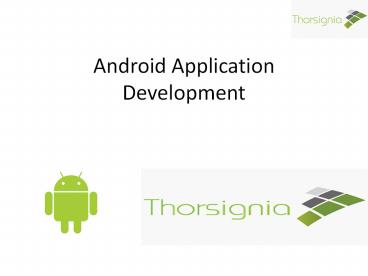Android App developers in Bangalore,India - PowerPoint PPT Presentation
Title:
Android App developers in Bangalore,India
Description:
Android App Development – With a technical enhanced team of Android App Developers in Bangalore,Thorsignia is bringing ideas into life. Our brilliant and sustained effort makes us the leading Android App Development Company in Bangalore. – PowerPoint PPT presentation
Number of Views:57
Title: Android App developers in Bangalore,India
1
Android Application Development
2
Introduction to Android
- A brief guide to the Android Application
Development Environment
3
Topics
- Background
- Introduction to Android
- Overview of Sensors
- Programming Tutorial 1 Tracking location with
GPS and Google Maps - Overview of Networking
- Programming Tutorial 2 Downloading from the
Internet - Programming Tutorial 3 Sending/Receiving SMS
Messages - Questions/Comments
- Resources
4
Background
- Software platform from Google and the Open
Handset Alliance - July 2005, Google acquired Android, Inc.
- November 2007, Open Handset Alliance formed to
develop open standards for mobile devices - October 2008, Android available as open source
- December 2008, 14 new members joined Android
project
5
Update History
6
Platform Versions
7
Android and the Hardware
- Built-in Apps Apps created in SDK
- Leverage Linux kernel to interface with hardware
- Open source platform promotes development from
global community
8
Android Features
- Reuse and replacement of components
- Dalvik virtual machine
- Integrated browser
- Optimized graphics
- SQLite
- Media support
- GSM Telephony
- Bluetooth, EDGE, 3G, and WiFi
- Camera, GPS, compass, and accelerometer
- Rich development environment
9
Android Architecture
10
Application Fundamentals
- Apps are written in Java
- Bundled by Android Asset Packaging Tool
- Every App runs its own Linux process
- Each process has its own Java Virtual Machine
- Each App is assigned a unique Linux user ID
- Apps can share the same user ID to see each
others files
11
Application Components
- Activity
- Present a visual user interface for one focused
endeavor the user can undertake - Example a list of menu items users can choose
from - Services
- Run in the background for an indefinite period of
time - Example calculate and provide the result to
activities that need it - Broadcast Receivers
- Receive and react to broadcast announcements
- Example announcements that the time zone has
changed - Content Providers
- Store and retrieve data and make it accessible to
all applications - Example Android ships with a number of content
providers for common data types (e.g., audio,
video, images, personal contact information,
etc.) - Intents
- Hold the content of a message
- Example convey a request for an activity to
present an image to the user or let the user edit
some text
12
Installation
- http//developer.android.com/sdk/installing.html
- Preparing your system and system requirements
- Downloading and Installing the SDK
- Installing ADT plug-in for Eclipse
- Adding Platforms and Components
- Exploring the SDK
- Completing tutorials
- Troubleshooting
13
Overview of Sensors
- The Android Sensor Platform and how to use it
14
Hardware-oriented Features
Feature Description
Camera A class that enables your application to interact with the camera to snap a photo, acquire images for a preview screen, and modify parameters used to govern how the camera operates.
Sensor Class representing a sensor. Use getSensorList(int) to get the list of available Sensors.
SensorManager A class that permits access to the sensors available within the Android platform.
SensorEventListener An interface used for receiving notifications from the SensorManager when sensor values have changed. An application implements this interface to monitor one or more sensors available in the hardware.
SensorEvent This class represents a sensor event and holds information such as the sensor type (e.g., accelerometer, orientation, etc.), the time-stamp, accuracy and of course the sensor's data.
MediaRecorder A class, used to record media samples, that can be useful for recording audio activity within a specific location (such as a baby nursery). Audio clippings can also be analyzed for identification purposes in an access-control or security application. For example, it could be helpful to open the door to your time-share with your voice, rather than having to meet with the realtor to get a key.
GeomagneticField This class is used to estimated estimate magnetic field at a given point on Earth, and in particular, to compute the magnetic declination from true north.
FaceDetector A class that permits basic recognition of a person's face as contained in a bitmap. Using this as a device lock means no more passwords to remember biometrics capability on a cell phone.
15
Sensor and Sensor Manager
- Sensor type (Sensor class)
- Orientation, accelerometer, light, magnetic
field, proximity, temperature, etc. - Sampling rate
- Fastest, game, normal, user interface.
- When an application requests a specific sampling
rate, it is really only a hint, or suggestion, to
the sensor subsystem. There is no guarantee of a
particular rate being available. - Accuracy
- High, low, medium, unreliable.
16
Programming Tutorial
- Simulating an Android application that accesses
positioning sensors
17
Preparing for the Tutorial
- Must have Eclipse IDE installed
- Must have Android SDK installed
- Must have knowledge of Java
- Must have the external Google Maps library
installed in your SDK environment. The Maps
library is included with the Google APIs add-on,
which you can install using the Android SDK and
AVD Manager.
18
Create an Android Virtual Device (AVD)
- Defines the system image and device settings used
by the Emulator - To create an AVD in Eclipse
- Select Window gt Android SDK and AVD Manager.
- The Android SDK and AVD Manager displays.
- Make sure the entry for Virtual Devices is
selected and click New. - The Create new AVD window displays.
- Enter a Name for the AVD.
- Select Google APIs (API level 3) as the Target.
- Click Create AVD.
- Close the Android SDK and AVD Manager.
19
Create the Android Project
- To create the project in Eclipse
- Select File gt New gt Project.
- Select Android Project in the Android folder and
click Next. - Enter GPSSimulator as the Project Name.
- Select Google APIs (Platform 1.5) as the Build
Target. - Enter GPSSimulator as the Application name.
- Enter com.android.gpssimulator as the Package
name. - Enter GPSSimulator as the Activity name.
- Click Finish.
20
The New Android Project
21
Modify the AndroidManifest.xml File
- Add permissions for GPS
- To modify the AndroidManifest.xml file
- Click on the res folder in the GPSSimulator
project. - Double-click AndroidManifest.xml to display the
GPSSimulator Manifest. - Enter the following lines before the application
tag. - ltuses-permission androidnameandroid.permission.
ACCESS_FINE_LOCATION /gt - Save the changes to the file.
22
Test the GPSSimulator
- To test in Eclipse
- Switch to DDMS view.
- Find the Location Controls in the Emulator
Control tab. - Click the GPX tab and click Load GPX.
- Locate and select the GPX file.
- Click Play to begin sending coordinates to the
Emulator.
23
View the Location on the Map
24
Internet Layers
- The Internet, is based on a layered architecture
called the TCP/IP stack. - Link Layer
- Protocols ARP and RARP
- Internet Layer
- Protocols IP, ping, etc.
- Transport
- Protocols TCP and UDP
- Application Layer
- Protocols HTTP, FTP, DNS, etc.
25
Client-Server Communication
- A server machine is identified on the Internet by
some IP address - Daemons are the processes running in the
background which are listening all the time for
connection requests from clients on a particular
port number. - Once a connection request comes into the server
on a given port, the corresponding daemon can
choose to accept it, and if so, a connection is
established. - Then the application layer protocol is typically
used for the client to get or send data to the
server.
26
More details visit Us
http//thorsignia.in/































